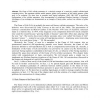139 search results - page 8 / 28 » How Common Can Be Universality for Cellular Automata |
RAS
2006
13 years 7 months ago
2006
Self-reconfigurable robots are built from modules, which are autonomously able to change the way they are connected. Such a robot can, through this self-reconfiguration process, c...
CN
2007
13 years 7 months ago
2007
In recent years, network mobility (NEMO) has been studied extensively due to its potential applications in military and public transportation. NEMO basic support protocol (NBSP), ...
SASO
2008
IEEE
14 years 2 months ago
2008
IEEE
—When programming a spatial computing medium such as a cellular automaton, the hop count distance to some set of sources (particles) is an often used information. In particular, ...
ALIFE
2010
13 years 8 months ago
2010
Edgar Codd's 1968 design for a self-replicating cellular automata machine has never been implemented. Partly this is due to its enormous size but we have also identified four...
CORR
2004
Springer
13 years 7 months ago
2004
Springer
: The Game of Life cellular automaton is a classical example of a massively parallel collision-based computing device. The automaton exhibits mobile patterns, gliders, and generato...

